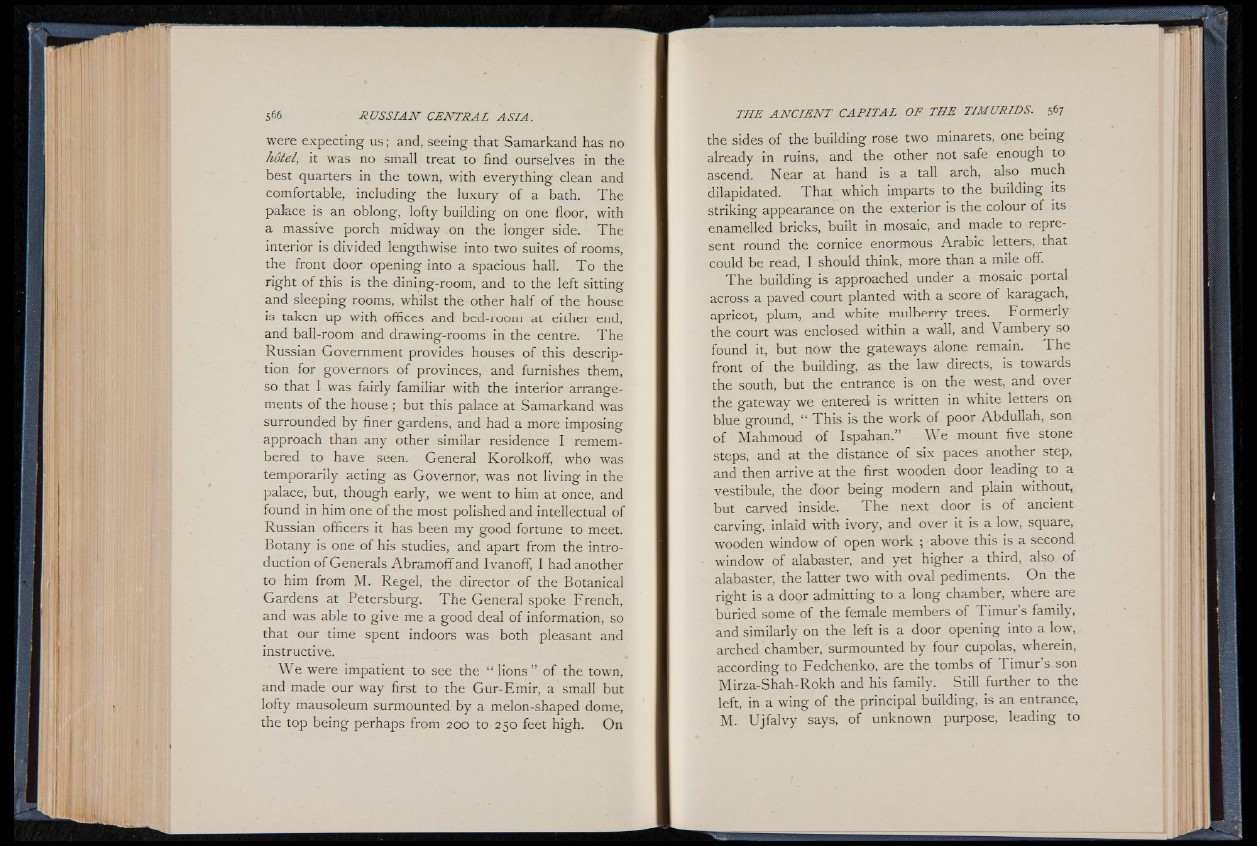
were expecting u s ; and, seeing that Samarkand has no
hotel, it was no small treat to find ourselves in the
best quarters in the town, with everything clean and
comfortable, including the luxury of a bath. The
palace is an oblong, lofty building on one floor, with
a massive porch midway on the longer side. The
interior is divided lengthwise into two suites of rooms,
the front door opening into a spacious hall. To the
right of this is the dining-room, and to the left sitting
and sleeping rooms, whilst the other half of the house
is taken up with offices and bed-room at either end,
and ball-room and drawing-rooms in the centre. The
Russian Government provides houses of this description
for governors of provinces, and furnishes them,
so that I was fairly familiar with the interior arrangements
of the house ; but this palace at Samarkand was
surrounded by finer gardens, and had a more imposing
approach than any other similar residence I remembered
to have seen. General Korolkoff, who was
temporarily acting as Governor, was not living in the
palace, but, though early, we went to him at once, and
found in him one of the most polished and intellectual of
Russian officers it has been my good fortune to meet.
Botany is one of his studies, and apart from the introduction
of Generals Abramoff and Ivanoff, I had another
to him from M. Regel, the director of the Botanical
Gardens at Petersburg. The General spoke French,
and was able to give me a good deal of information, so
that our time spent indoors was both pleasant and
instructive.
We were impatient to see the “ lions” of the town,
and made our way first to the Gur-Emir, a small but
lofty mausoleum surmounted by a melon-shaped dome,
the top being perhaps from 200 to 250 feet high. On
the sides of the building rose two minarets, one being
already in ruins, and the other not safe enough to
ascend. Near at hand is a tall arch, also much
dilapidated. That which imparts to the building its
striking appearance on the exterior is the colour of its
enamelled bricks, built in mosaic, and made to represent
round the cornice enormous Arabic letters, that
could be read, I should think, more than a mile off.
The building is approached under a mosaic portal
across a paved court planted with a score of karagach,
apricot, plum, and white mulberry trees. Formerly
the court was enclosed within a wall, and Vambery so
found it, but now the gateways alone remain. The
front of the building, as the law directs, is towards
the south, but the entrance is on the west, and over
the gateway we entered is written in white letters on
blue ground, “ This is the work of poor Abdullah, son
of Mahmoud of Ispahan.” We mount five stone
steps, and at the distance of six paces another step,
and then arrive at the first wooden door leading to a
vestibule, the door being modern and plain without,
but carved inside. The next door is of ancient
carving, inlaid with ivory, and over it is a low, square,
wooden window of open work ; above this is a second
window of alabaster, and yet higher a third, also of
alabaster, the latter two with oval pediments. On the
right is a door admitting to a long chamber, where are
buried some of the female members of Timur’s family,
and similarly on the left is a door opening into a low,
arched chamber, surmounted by four cupolas, wherein,
according to Fedchenko, are the tombs of Timur’s, son
Mirza-Shah-Rokh and his family. Still further to the
left, in a wing of the principal building, is an entrance,
M. Ujfalvy says, of unknown purpose, leading to